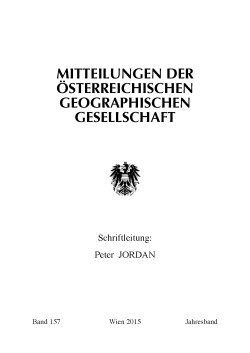 |
 |
Österreichische Geographische Gesellschaft
Mitteilungen der Österreichischen Geographischen Gesellschaft
157. Jg. (Jahresband), Wien 2015
Anton Gosar,
Dejan Cigale
S. 195 - 228 doi: 10.1553/moegg157s195
Abstract:
The paper discusses geographical characteristics of Slovenia from the perspective of tourism development and presents main processes that have marked it in the last decades. Tourism has significantly affected the appearance as well as economic and social structure of many Slovenian regions. The paper focuses on the role of various factors, which influenced tourist attraction of Slovenia and its regions, as well as on changes in tourism supply and demand in the last decades and their relation to some of the political and economic events. Recently, Slovenia has experienced an above-average rate of tourism growth. Several of the nation-state’s geopolitical decisions impacted the growth of the tourism economy: Slovenia became a member of the European Union (EU) and the North Atlantic Treaty Organisation (NATO) (2004), introduced the Euro as the national currency (2007) and became a full member of the Schengen Space (2009). However, impacts of these changes were not comparable to the impacts of political and economic disruptions, related to the disintegration of Yugoslavia, which caused drastic decline in foreign tourists’ numbers at the beginning of the 1990s. Despite long-term growth trends, tourism in Slovenia is already facing many challenges (e.g., unreliable snow cover in the winter season in Alpine resorts as a result of the climate change impacts). Moreover, the growth of tourism has caused some environmental and social problems (or at least contributed to them) in those areas where tourism development has been the most intensive. Nevertheless, impacts of tourism have been rather limited. One of the important reasons why, so far, tourism has not caused any large-scale environmental or social problems is the fact that Slovenia has not developed real mass tourism. In the European context, Slovenia remains an only moderately developed tourist destination. Due to the growing competition on the global tourism market a continuous adaptation to the changing tourism demand is of crucial importance, taking into account not just short-term gains, but especially tourism sector’s long-term viability. From this perspective, also sustainable tourism principles should be considered more relevant.
tourism development, Slovenia, tourism regions, natural and cultural heritage Published Online:
2016/02/16 12:14:17 Object Identifier:
0xc1aa5576 0x0032bbbf
Rights:All rights reserved.For questions regarding copyright and copies please contact us by email.
Themenschwerpunkt
„Zehn Jahre EU-Osterweiterung – geographische Bilanz eines mutigen Schrittes“
Die Fachzeitschrift "Mitteilungen der Österreichischen Geographischen Gesellschaft" (früher "Mitteilungen der k.k. Geographischen Gesellschaft in Wien")
• ist das wichtigste regelmäßig erscheinende Organ der "Österreichischen Geographischen Gesellschaft",
erscheint seit 1857 und ist die älteste noch existierende Fachzeitschrift geographischen Inhaltes im deutschen Sprachraum,
• vermittelt neue Erkenntnisse aus allen Bereichen der Geographie, Kartographie und verwandter Raumwissenschaften,
• informiert über Fachfragen in Forschung und Lehre, nationale und internationale geographische Aktivitäten, sowie Personalia,
• veröffentlicht die Österreich-Bibliographie und Rezensionen der neuesten Literatur,
publiziert Gesellschaftsnachrichten,
• erscheint im Umfang von mindestens 400 Druckseiten (mit Kartenbeilagen) im Jahr
|


 Home
Home Print
Print
 References
References
 Share
Share

